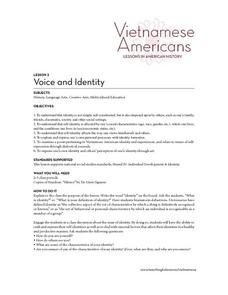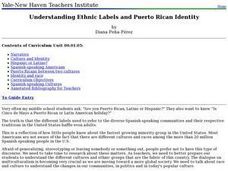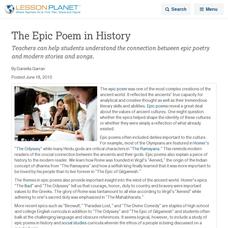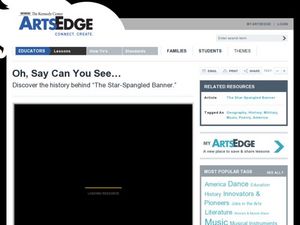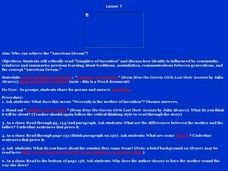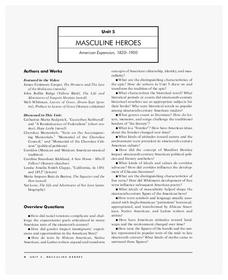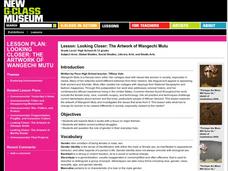Little Stones
How Can Poetry Make People Think and Care?
Can beautiful words change the world? Literary scholars discover how to paint their visions of change using poetry in a series of three workshops. Each independent topic gives participants a chance to examine their feelings about...
Annenberg Foundation
Rhythms in Poetry
Rhyme, rhythm, free verse, imagery: Do these words describe poetry, or jazz music? The answer is both! A resource explores these similarities as scholars watch a video, engage in discussion, read author biographies, write poetry and...
Facing History and Ourselves
Identity and Place
Build scholars' ability to understand their own values and learn about World War II at the same time. Scholars write poetry and discuss identity and place in depth with an in-depth social studies resource.
Facing History and Ourselves
Identity and Names
Would a rose smell as sweet, as Juliet Capulet asserts, if called by any other name? The importance of names and the connection between names and identity are examined in a lesson that explores identity in the United States. After...
Facing History and Ourselves
What Shapes Your Identity?
Sixth graders explore their individual identities. In this personal identity activity, 6th graders write biopoems using the provided template. Students share their poems and respond to the poetry shared.
National Endowment for the Humanities
Understanding the Context of Modernist Poetry
Students examine the historical, social, and cultural context of modernist poetry. They explore websites, complete a chart, compare/contrast rural and urban life, watch a video of early New York, and complete a writing assessment...
Facing History and Ourselves
Bio-poem: Connecting Identity and Poetry
Writing a bio-poem is a great way to have young scholars go below the surface and reflect on who or what has made them who they are. Check out this richly detailed lesson that provides step-by-step directions for crafting a bio-poem.
Curated OER
Identity: A Path to Self-Esteem
Sixth graders participate in a brainstorming activity in which they identify the types of decisions they make everyday. Individually, they complete a worksheet on making decisions effectively. After reading a poem, they identify the...
Teaching Tolerance
Vietnamese Americans: Voice and Identity
Students explore the concept that one's identity is imposed by others, such as one's family, friends, classmates, society, age, race, gender and socioeconomic status. They assess a poem pertaining to Vietnamese American identity and...
Curated OER
Understanding Ethnic Labels and Puerto Rican Identity
Students brainstorm a list of stereotypes associated with the Hispanic or Latin culture. In groups, they use the internet to research issues of importance to the Puerto Rican community. They focus on the cultures that speak Spanish and...
National Museum of the American Indian
Fritz Scholder: A Study Guide
In this engaging activity involving close analysis of abstract expressionist art, your class members will not only discover more about artist Friz Scholder's Native American art, but they will also have the opportunity to consider...
Curated OER
The Epic Poem in History
Teachers can help students understand the connection between epic poetry and modern stories and songs.
Facing History and Ourselves
Dual Identities
Many of us have multiple identities. There's who we are at home, school, friends, and strangers. And often these identities come with different names. The third activity in the First Days of School series examines how names reflect...
Learning for Justice
Maya Angelou
Maya Angelou's poem, "Still I Rise", offers young scholars an opportunity to consider how poets use literary devices to create powerful messages. After a close reading and discussion of the poem, class members reflect on how they can...
Facing History and Ourselves
What Aspects of Our Identities Do We Show to Others?
Sixth graders consider how they present their personal identities. In this character education lesson plan, 6th graders define themselves as they create masks that represent their personalities. Students share their masks and discuss...
Anti-Defamation League
Understanding and Analyzing “The U.S. of Us” by Richard Blanco
Current immigration issues and the rhetoric surrounding the controversies come into focus with a lesson that uses Richard Blanco's anthem, "The U.S. of Us," written after the August 2019 attack in El Paso, Texas, to open a discussion of...
Curated OER
Border Poetry/Writing Workshop
Learners analyze a poem set in the U.S.-Mexico borderlands and defend their own interpretations of the work. They demonstrate understanding of poetic technique by writing their own poems of living on the border.
Curated OER
Grappling with Identity in Latino Poetry
Students identify some common themes involving the Latino immigrant experience as conveyed through a variety of media, explore issues of identity in some examples of poetry written by Latinos and learn some basic poetry reading strategies.
Curated OER
Pieces of the World
Learners locate Australia in relation to rest of world, read poem Pieces of the World by Mervyn James, explore kinds of journeys that Australians have made, and examine their effects - the emotions, the realities and the practicalities.
Curated OER
Oh Say Can You See?
Students discover the meaning of patriotism through literature, songs, and poetry. They also identify patriotic symbols and activities such as the flag, the Pledge of Allegiance, the Star Spangled Banner, the bald eagle, and monuments.
Curated OER
Who Can Achieve the "American Dream"
Exploring the idea of working to achieve the American Dream, the class reads an excerpt from How the Garcia Girls Lost their Accents by Julia Alvarez. Following, the class analyzes the excerpt and discusses the theme of the reading using...
Annenberg Foundation
Utopian Promise
Scholars learn all about the Puritans in the third installment of a 16-part lesson series. After watching a video, they read and discuss biographies of Puritans and Quakers from American history, write journal entries and poetry, and...
Annenberg Foundation
Masculine Heroes
What were the driving forces behind American expansion in the nineteenth century, and what were its effects? Scholars watch a video, read biographies, engage in discussion, write journals and poetry, draw, and create a multimedia...
Curated OER
Lesson: Looking Closer: The Artwork of Wangechi Mutu
Social issues of gender and media stereotypes, begins with a multi-sensory experience. Learners view the painting Backlash Blues and make critical comments based on what they see. They then read the Langston Hughes poem and listen to the...








